Vered Neta's Blog, page 8
March 14, 2024
7 Research Lifesavers for Historical Fiction Writers
As a fiction writer, you often find yourself walking a tightrope between fact and creativity. On one hand, you want your stories to be rooted in reality, grounded in the details that make your worlds believable. On the other hand, you crave the freedom to let your imagination soar, crafting narratives that transport readers to new and exciting places.
This becomes even more complicated when you wish to write a historical novel. So, how can you find the perfect balance between research and creativity? This was my dilemma when I wrote my historical novel “Full Circle” which takes place in Prague in 1968 during the Prague Spring
Here are some tips to help you navigate this delicate dance, accompanied by examples from books that have mastered this balance with finesse.
7 Tips for Writing Historical Novels Without Drowning in Research.

#1 – Target Your Research.
Resist the urge to become a time period expert! Identify specific aspects crucial to your plot or characters. Are you writing about a naval battle? Focus on ship types and warfare tactics, not 18th-century wig trends.
For example, If you’re writing a story that takes place in Roman times in an army, researching the daily life of a Roman soldier would be more relevant than the political machinations of the Senate.
In “Mutiny on the Bounty,” Charles Nordhoff and James Hall meticulously detail the intricacies of 18th-century sailing manoeuvres and shipboard hierarchy, which directly impact the mutiny plot.
 #2 – Fiction First, Facts Later.
#2 – Fiction First, Facts Later.
Don’t let research stall your writing. Get your core plot and characters established first. Then, pinpoint areas needing historical grounding. This keeps the creative flow going and ensures research serves the story.
Write the story you’re passionate about, then refine the historical details later in the revision process.
In my book “Full Circle”, I first outlined the story and then identified what topics I needed to research. These topics included what typical food they had in communist Czechoslovakia, what the political prison looked like, the map of Prague in the 1960s, what newspapers they would read, etc.
Ken Follett, known for his meticulously researched historical thrillers like “Pillars of the Earth“, likely drafted the core narrative of the medieval monastery construction project before delving into specific architectural details.

#3 – Befriend Secondary Sources.
While primary sources like diaries offer rich flavour, consider the power of good historical overviews and academic journals. These provide a solid foundation without a deep dive.
Consider using online resources like historical encyclopedias or reputable websites alongside primary sources.
For “A Gentleman in Moscow”, Amor Towles’s novel set during the Russian Revolution, the author consulted secondary sources like historical timelines and biographies alongside personal accounts from the period.
When I wrote “Full Circle,” I couldn’t read primary sources as they are in Czech, which I am not familiar with; however, I could listen to interviews done in English, after the Prague Spring, with some of the student demonstrators, which described student life in that period to give a better impression of how it felt to be a student during that time in Prague.

#4 – Know When to Take Creative Liberties.
While accuracy is essential, there are times when it’s acceptable (and even necessary) to take creative liberties for the sake of storytelling.
Whether compressing timelines, embellishing details, or inventing fictional elements, feel free to bend the rules if it serves the greater narrative.
Historical accuracy is important, but the creative license is your superpower! Don’t be afraid to bend facts for a compelling narrative. Just ensure the changes feel believable within the established historical context.Remember, it’s YOUR story.
In “The Shadow of the Wind” (one of my all-time favourite book) by Carlos Ruiz Zafón, set in Barcelona after the Spanish Civil War, the author creates a fictional labyrinthine library but ensures the social and political climate of post-war Spain feels real.

#5 – Balance Exposition with Immersion.
One of the worst mistakes historical writers can make is starting with an “info dump”. When incorporating research into your narrative, balance exposition and immersion.
Avoid overwhelming readers with info dumps; instead, seamlessly integrate factual details into the fabric of your story to enhance world-building and character development.
Anthony Doerr’s “All the Light We Cannot See” masterfully weaves historical details into the narrative without sacrificing pacing or storytelling. Through vivid descriptions and subtle allusions, Doerr transports readers to World War II-era Europe, immersing them in the lives of his characters against the backdrop of a tumultuous period in history.
 #6 – Seek Authentic Voices.
#6 – Seek Authentic Voices.
When writing characters from different backgrounds or cultures, seek authentic voices and perspectives to ensure accurate representation.
This might involve conducting interviews, reading firsthand accounts, or consulting with cultural experts to capture the nuances of diverse experiences.
Chimamanda Ngozi Adichie’s “Americanah” follows the journey of a young Nigerian woman navigating life in the United States. Adichie draws on her experiences as a Nigerian immigrant to create authentic characters and explore themes of identity, race, and belonging with depth and sensitivity.

#7 – Know When to Stop.
This is the most important tip. It’s easy to get caught up in the research phase, continuously seeking new information and delving deeper into historical details. However, there comes a point where you need to trust your instincts, draw a line, and begin writing. Here’s why:
Avoid Paralysis by Analysis : Researching endlessly without ever starting to write can lead to analysis paralysis. You may feel overwhelmed by the sheer volume of information or constantly second-guessing whether you have enough knowledge to begin. Remember, writing is a creative process, and sometimes you need to jump in and start swimming, even if you don’t know every detail about the historical period yet. Immerse Yourself in the Writing Process : Writing is where the magic happens. It’s where you bring your characters to life, develop your plot, and craft your narrative voice. By diving into the writing process, you’ll better understand your story and its historical context. You’ll uncover new insights and connections you may not have discovered through research alone. Research as You Go : Writing and research go hand in hand. As you write, you’ll inevitably encounter gaps in your knowledge or areas that require further exploration. Instead of trying to anticipate every detail beforehand, embrace the process of research as you go along. This approach allows for a more organic integration of historical details into your narrative rather than overwhelming your readers with info dumps. Trust Your Creative Instincts : As a writer, your unique voice and vision drive your storytelling. Trust your instincts and intuition when crafting your historical novel. While historical accuracy is important, don’t let it stifle your creativity or dictate every aspect of your narrative. Allow yourself the freedom to take creative liberties when necessary, always keeping the essence of your story at the forefront. Set Realistic Boundaries : Set realistic boundaries for your research phase. Determine how much time and effort you will dedicate to researching before transitioning to the writing stage. By setting clear boundaries, you’ll prevent yourself from getting lost in an endless cycle of research and ensure that you progress towards bringing your story to life.In “The Book Thief” by Markus Zusak, the story is set in Nazi Germany during World War II, and the author paints a vivid and harrowing picture of life under the oppressive regime.
While Zusak’s portrayal of historical events and settings is grounded in meticulous research, he also knows when to stop and focus on the emotional core of the story. The novel is ultimately a powerful exploration of humanity and resilience in the face of unimaginable adversity, reminding us that the true heart of historical fiction lies in its ability to capture the human experience.
In Conclusion – research is an indispensable tool for fiction writers, offering a wealth of inspiration and insights to enrich our stories.
By striking the right balance between fact and creativity, we can create narratives that captivate readers while staying true to the essence of our stories. So, embrace the research process, let your imagination soar, and create worlds that resonate with authenticity and imagination.
Now it’s YOUR turn – I would love to hear your tips and ideas how to balance research and creativity
Would love to get your input in the comment box below.
The post 7 Research Lifesavers for Historical Fiction Writers appeared first on Vered Neta.
March 7, 2024
POV Mastery – Themes and Atmosphere
Following a discussion about what point of view (POV) a story should be written on one of my favourite Facebook groups, I realised how important that question is.
Crafting a captivating narrative involves more than just spinning a tale; it requires a deliberate choice of perspective through which the story unfolds. Point of view (POV) serves as the lens through which readers perceive a story’s events, characters, and emotions, making it a crucial element of narrative technique.
One crucial aspect of storytelling is selecting the right point of view to tell your tale. Point of view dictates how readers perceive your story’s events, characters, and emotions, making it a fundamental element of narrative technique.
So, let’s explore the significance of point of view and provide guidance on selecting the most suitable perspective for your story.
First, let’s understand what point of view means regarding the art of writing. Point of view refers to the narrative perspective from which a story is told. It determines who is telling the story and how much access readers have to the characters’ thoughts, feelings, and experiences.
The Three Primary POV Commonly Used in Literature: #1. First Person: In first-person POV, the narrator is a character within the story, typically using “I” or “we” pronouns. This perspective offers a direct and intimate connection to the narrator’s thoughts and emotions but limits the reader’s knowledge of what the narrator knows.
#1. First Person: In first-person POV, the narrator is a character within the story, typically using “I” or “we” pronouns. This perspective offers a direct and intimate connection to the narrator’s thoughts and emotions but limits the reader’s knowledge of what the narrator knows.
Look at the “The Hunger Games” by Suzanne Collins: “I woke with a start, the sheets tangled around my legs. Sunlight streamed weak and watery through the cracks in the wooden shutters. For a moment, I couldn’t remember where I was. Then the events of yesterday flooded back and I squeezed my eyes shut. Peeta. He was gone. Reaping day. The chariot ride. The training center. Peeta. He was alive.”
Why it works: This excerpt throws the reader directly into Katniss Everdeen’s experience, allowing us to share her confusion, fear, and determination as she navigates the brutal world of the Hunger Games.
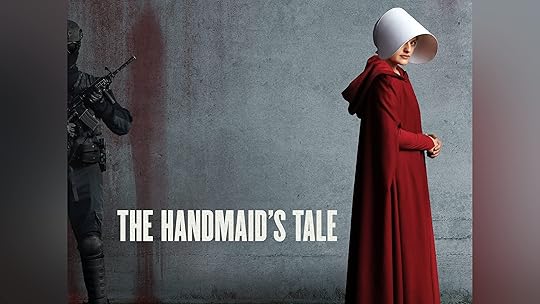 #2. Third Person Limited: Third-person limited POV follows the story through the eyes of a single character, using “he,” “she,” or “they” pronouns. While it maintains some distance from the characters, it still provides insights into their thoughts and emotions, albeit from a more restricted viewpoint.
#2. Third Person Limited: Third-person limited POV follows the story through the eyes of a single character, using “he,” “she,” or “they” pronouns. While it maintains some distance from the characters, it still provides insights into their thoughts and emotions, albeit from a more restricted viewpoint.
Think of “The Handmaid’s Tale” by Margaret Atwood: “Offred sat before the Commander, eyes downcast. Her heart hammered a frantic tattoo against her ribs, but her face, as she’d been instructed, remained expressionless. She wasn’t supposed to look at him. Not directly. Only sideways, out of the corner of her eye. Wives could look at him, but not her.”
Why it works: This excerpt restricts the reader’s perspective to Offred’s limited knowledge and understanding of her oppressive world, creating a sense of claustrophobia and highlighting her restricted agency
 #3. Third-Person Omniscient: Third-person omniscient POV allows the narrator to have full knowledge of all characters’ thoughts, feelings, and experiences. This perspective offers a broader scope and can delve into multiple characters’ perspectives, providing a comprehensive view of the story’s world.
#3. Third-Person Omniscient: Third-person omniscient POV allows the narrator to have full knowledge of all characters’ thoughts, feelings, and experiences. This perspective offers a broader scope and can delve into multiple characters’ perspectives, providing a comprehensive view of the story’s world.
One of my favourite examples is “Pride and Prejudice” by Jane Austen: “It is a truth universally acknowledged, that a single man in possession of a good fortune, must be in want of a wife.”
Why it works: The opening line of “Pride and Prejudice” utilises omniscient narration, establishing the novel’s social commentary and satirical tone. This narrative voice allows the author to provide insights into the character’s thoughts and motivations while offering broader social observations.
As we can see, the POV is crucial to telling our story. Here are 7 reasons WHY it is crucial:
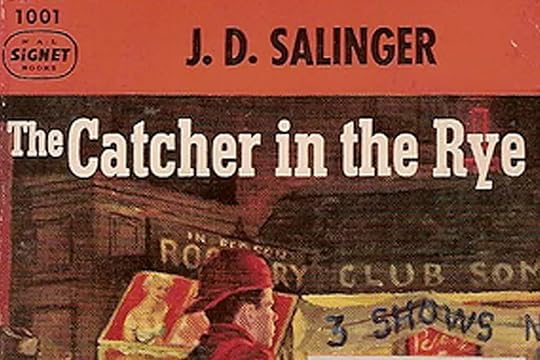 #1 – Character Depth and Complexity.
#1 – Character Depth and Complexity.
POV plays a crucial role in shaping the depth and complexity of characters within a story. The narrative perspective chosen by the author influences how readers perceive and understand the inner workings of the characters, including their thoughts, emotions, motivations, and personal growth throughout the narrative.
Examples:
First Person: In “The Catcher in the Rye” by J.D. Salinger, Holden Caulfield’s first-person narration offers an intimate portrayal of his complex psyche and troubled adolescence.Third Person Limited: In J.K. Rowling’s “Harry Potter” series, the third-person limited POV allows readers to delve into Harry Potter’s character, experiencing his joys, fears, and growth throughout his journey at Hogwarts.Third-person omniscient in “War and Peace” by Leo Tolstoy utilises this POV to provide readers with a panoramic view of Russian society during the Napoleonic Wars, offering insights into the lives and experiences of various characters across different social classes and backgrounds.
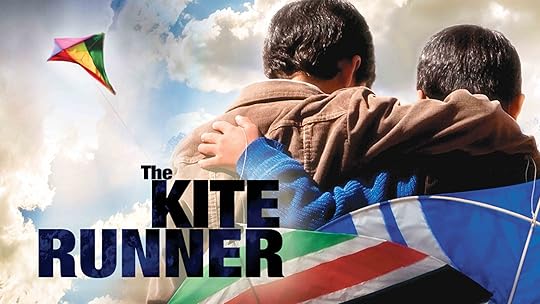 #2 – Reader Empathy and Engagement.
#2 – Reader Empathy and Engagement.
POV plays a pivotal role in shaping the reader’s emotional connection to the characters and their journey throughout the story. The narrative perspective chosen by the author influences how readers empathize with the characters, become invested in their struggles, and experience their triumphs and setbacks
Examples:
First Person: In “The Hunger Games” by Suzanne Collins, Katniss Everdeen’s first-person perspective immerses readers in her harrowing struggle for survival in the dystopian world of Panem.Third-Person Limited: In “The Kite Runner” by Khaled Hosseini, he utilises this POV to follow the journey of Amir, a young Afghan boy grappling with guilt, redemption, and the complexities of friendship and betrayal. Through Amir’s perspective, readers empathise with his internal struggles and moral dilemmas as he seeks forgiveness and redemption.Third-Person Omniscient: In “The Grapes of Wrath” by John Steinbeck, this POV is used to narrate the epic journey of the Joad family as they migrate from Oklahoma to California during the Great Depression. Through the omniscient narrator, readers empathise with the Joads and other characters as they confront poverty, injustice, and the quest for a better life.
 #3 – Narrative Voice and Tone.
#3 – Narrative Voice and Tone.
POV significantly influences the narrative voice and tone of the story, shaping its style, atmosphere, and overall mood. The choice of POV determines who is telling the story and how it is being conveyed to the reader, affecting the narrative voice and the emotional resonance of the storytelling.
Examples:
First Person: In F. Scott Fitzgerald’s “The Great Gatsby,” Nick Carraway’s first-person narration infuses the story with a reflective and nostalgic tone, capturing the glamour and disillusionment of the Jazz Age.Third-Person Limited: In “The Secret Life of Bees” by Sue Monk Kidd: this POV is used to follow Lily Owens’ coming-of-age journey, imbuing the narrative with a poignant and introspective tone. Through the third-person limited POV, readers experience the story through Lily’s eyes, allowing for a nuanced exploration of themes such as identity, family, and racial prejudice.Third Person Omniscient: In Leo Tolstoy’s “Anna Karenina,” the omniscient narrator provides a sweeping and authoritative tone, offering profound insights into the characters’ inner lives and societal dynamics in 19th-century Russia.
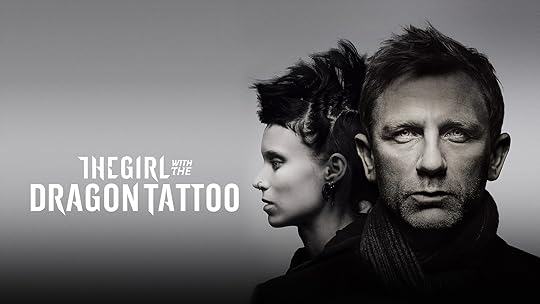 #4 – Revealing Information and Building Suspense.
#4 – Revealing Information and Building Suspense.
POV plays a crucial role in controlling how and when information is revealed to readers, influencing the pacing, tension, and overall suspense of the narrative. The narrative perspective chosen by the author determines the degree of access readers have to characters’ thoughts, motivations, and secrets, shaping the reader’s experience of unravelling the story’s mysteries and surprises.
Examples:
First Person: “The Tell-Tale Heart “ by Edgar Allan Poe: Edgar Allan Poe’s classic short story is narrated in first-person POV by an unnamed narrator who confesses to murdering an old man. Readers are drawn into the suspenseful tension through the narrator’s unreliable and increasingly erratic narration as they question the narrator’s sanity and moral compass.Third Person Limited: “The Girl with the Dragon Tattoo” by Stieg Larsson is written in the third-person limited POV to alternate between Mikael Blomkvist’s and Lisbeth Salander’s perspectives, creating a gripping and suspenseful narrative. Through their alternating POVs, readers are drawn into the complex investigation of a decades-old mystery and the dark secrets lurking beneath the surface of Swedish society.Third Person Omniscient: In “A Game of Thrones” by George R.R. Martin, the vast scope of the narrative necessitates an omniscient POV. By jumping between characters across different locations and storylines, the author keeps readers engaged and guessing about the fate of various characters and the potential consequences of their actions. The reader possesses knowledge that individual characters might not, creating a sense of anticipation and dread as the story unfolds.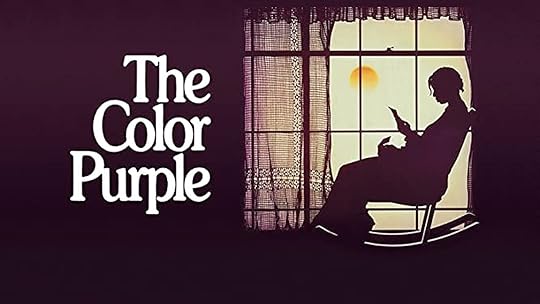 #5. Exploring Multiple Perspectives.
#5. Exploring Multiple Perspectives.
POV allows for exploring diverse perspectives and experiences within the narrative, enriching the storytelling by offering insights into different characters’ thoughts, emotions, and motivations. The choice of POV determines how extensively readers engage with various characters and their unique viewpoints, contributing to a richer and more nuanced understanding of the story’s themes and conflicts.
Examples:
First Person: “The Color Purple” by Alice Walker is written in a first-person POV to narrate the story of Celie, an African-American woman navigating racism, sexism, and abuse in the early 20th century. Through Celie’s intimate and introspective voice, readers experience her journey of self-discovery and empowerment and the interconnected lives of other characters in her community. Third-Person Limited: In the book “The Book Thief” by Markus Zusak: third-person limited is used to follow the perspective of Liesel Meminger, a young girl living in Nazi Germany during World War II. Through Liesel’s eyes, readers experience the impact of war and totalitarianism on ordinary lives and the power of literature and human resilience in the face of adversity.Third Person Omniscient: In Virginia Woolf’s “Mrs. Dalloway,” the omniscient narrator delves into various characters’ inner thoughts and emotions, providing multiple perspectives on a single day in post-World War I London.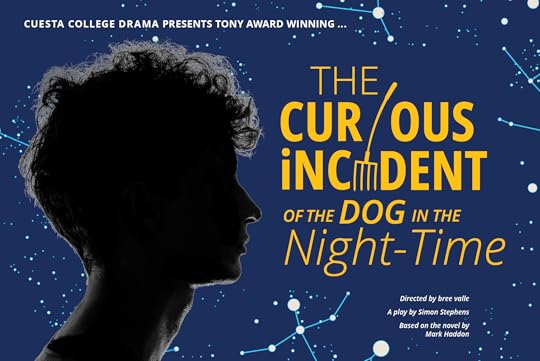 #6. Creating Distance or Intimacy.
#6. Creating Distance or Intimacy.
POV plays a crucial role in establishing the level of distance or intimacy between readers and the characters, influencing the reader’s emotional connection to the story and its characters. The narrative perspective chosen by the author determines how closely readers engage with the characters’ thoughts, emotions, and experiences, shaping their empathy and investment in the narrative.
Examples:
First Person: In the book “The Curious Incident of the Dog in the Night-Time” by Mark Haddon, the first-person narration offers an intimate glimpse into the world of Christopher Boone, a teenager with autism spectrum disorder. Through Christopher’s unique perspective, readers develop a deep empathy for his struggles and triumphs as he navigates the complexities of human emotions and social interactions.Third Person Limited: In Margaret Atwood’s “The Handmaid’s Tale,” the third-person limited POV of Offred offers a chilling and emotionally resonant portrayal of a dystopian society where women are oppressed and stripped of their autonomy.Third-Person Omniscient: “Pride and Prejudice” by Jane Austen offers readers insights into the thoughts and emotions of characters such as Elizabeth Bennet, Mr. Darcy, and their acquaintances. Through the omniscient narrator, readers develop a deep empathy for the characters’ romantic aspirations and social struggles while maintaining a sense of narrative distance. #7. Enhancing Theme and Atmosphere.
#7. Enhancing Theme and Atmosphere.
POV is a powerful tool that not only shapes the narrative structure but also plays a significant role in enhancing the theme and atmosphere of a story. The choice of POV influences how readers perceive the world of the story, the characters’ experiences, and the overarching themes explored by the author.
Examples:
First Person: “The Great Gatsby” by F. Scott Fitzgerald provides readers with a subjective exploration of themes such as the American Dream, wealth, and morality. Through Nick’s perspective, readers experience the glittering decadence of the Jazz Age and the disillusionment lurking beneath the surface.Third Person Limited: “1984” by George Orwell utilises third-person limited POV to delve into themes of totalitarianism, surveillance, and individual freedom through the experiences of Winston Smith. Through Winston’s perspective, readers experience the oppressive atmosphere of the dystopian society depicted in the novel.Third Person Omniscient: In Gabriel García Márquez’s “One Hundred Years of Solitude,” the omniscient narrator weaves a tapestry of magical realism and familial saga, capturing the cyclical nature of history and the human condition in the fictional town of Macondo.In Conclusion – mastering the art of point of view (POV) is paramount for crafting narratives that captivate and immerse readers. While there’s undoubtedly much more to explore about POV across different genres and how to blend them skillfully, the key lies in understanding its profound impact on storytelling.
By carefully considering the seven pivotal reasons we’ve discussed and drawing insights from literary examples, writers can unlock the transformative power of POV to elevate their narratives and forge profound connections with readers.
So, whether you’re delving into the intimate depths of first-person narration or navigating the vast landscapes of third-person omniscient perspective, remember that POV isn’t just a narrative choice; it’s the compass guiding your readers on a journey of discovery and emotion.
Now it’s YOUR turn – What is YOUR favourite POV and give us some examples from books that you have enjoyed them in.
Would love to get your input in the comment box below.
The post POV Mastery – Themes and Atmosphere appeared first on Vered Neta.
February 29, 2024
The Power of Hooks – Grabbing Attention from the Start
In today’s fast-paced world, making a lasting impression is key. We’ve all heard about the crucial first 10 seconds in an interview, or how scriptwriters have just three pages to hook their readers. And for authors? Well, they say you’ve only got about ten pages to get a green light for your project.
In a world where content is king and attention spans are shrinking by the second, captivating your audience from the get-go is absolutely vital. Whether you’re weaving a tale on paper or crafting a visual masterpiece on the big screen, mastering the art of the hook is your golden ticket to drawing in your audience and keeping them engaged.
So, how do you do it? Here are 10 Ways to Achieve it:
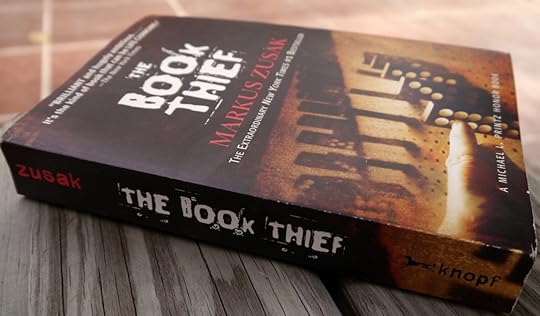
#1 – Start with a Vivid Scene.
Dive right into the action by painting a vivid scene that grabs your audience’s attention and sets the stage for what’s to come.
Think of Markus Zusak’s “The Book Thief,” which opens with a gripping scene in Nazi Germany, immediately immersing readers in the story’s sombre tone.
On the screen, consider the film “The Shawshank Redemption,” which opens with the visually striking and emotionally gripping scene of Andy Dufresne standing in the rain outside his home.
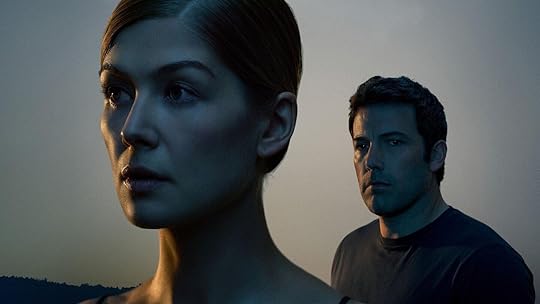 #2 – Pose a Compelling Question.
#2 – Pose a Compelling Question.
Engage your audience’s curiosity by posing a thought-provoking question inviting them to participate actively in your story.
Take Gillian Flynn’s “Gone Girl,” where the first line “When I think of my wife, I always think of her head,” immediately raises questions about the narrator’s relationship and sets a mysterious tone.
In cinema, consider “Interstellar,” which begins with a question posed by the protagonist, Cooper, about the survival of humanity in a world ravaged by environmental collapse, setting the tone of the film’s for the exploration of space exploration and the human condition.
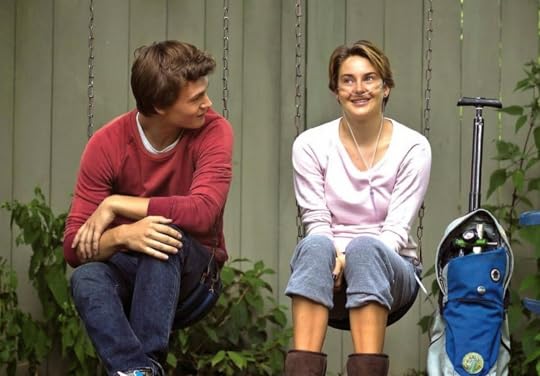
#3 – Introduce an Intriguing Character.
Hook your audience by introducing a captivating character right off the bat.
Think of “Deadpool,” where the irreverent and wisecracking anti-hero is introduced in the midst of a chaotic action sequence, setting the tone for the film’s humour and irreverence.
In literature, consider “The Fault in Our Stars” by John Green, where the protagonist Hazel Grace Lancaster’s witty and self-aware narration immediately endears her to readers.
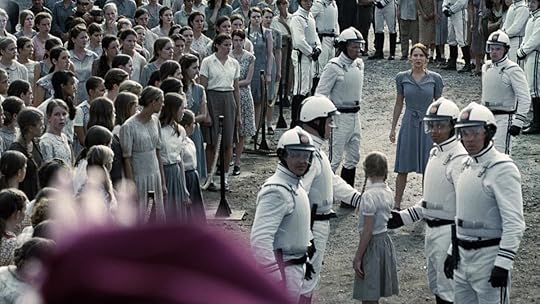
#4 – Create Immediate Conflict.
Thrust your audience into the heart of the action by creating immediate conflict that grabs their attention and sets the stage for the story’s central conflicts and themes.
Consider Suzanne Collins’ “The Hunger Games,” where immediate conflict is established as Katniss Everdeen volunteers as tribute, setting the stage for the novel’s exploration of survival and rebellion.
In cinema, think of “Jurassic Park,” where immediate conflict is established in the opening scenes as a team of workers struggles to transport a caged Velociraptor.
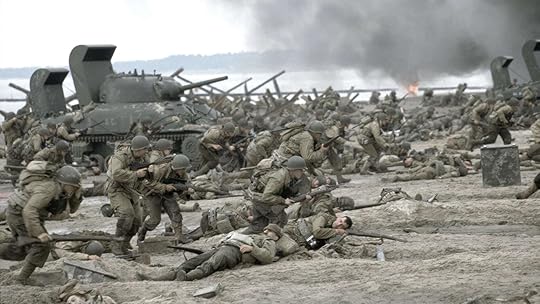
#5 – Use Shock Value.
Make a lasting impact by incorporating shock value to elicit strong emotional reactions from your audience.
Consider “Saving Private Ryan,” where the intense and realistic depiction of the Omaha Beach landing immediately grabs viewers’ attention and sets the tone for the film’s portrayal of the brutality of war.
In literature, think of “The Girl with the Dragon Tattoo” by Stieg Larsson, which begins with a scene depicting the protagonist, journalist Mikael Blomkvist, being convicted of libel against a businessman.
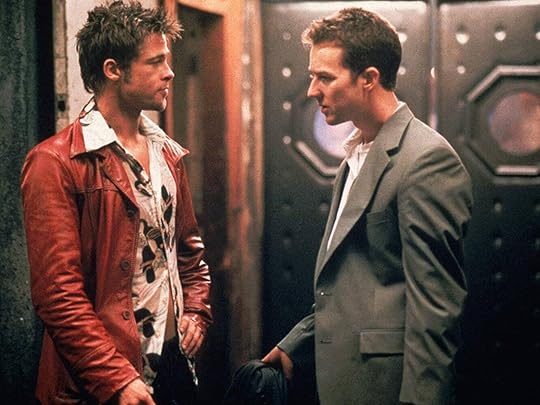 #6 – Drop a Bombshell Revelation.
#6 – Drop a Bombshell Revelation.
Keep your audience on their toes by dropping a bombshell revelation that fundamentally changes their understanding of the narrative.
Think of “The Da Vinci Code,” where the revelation of the curator’s murder sets off a thrilling quest for the truth.
In cinema, consider “Fight Club,” where the bombshell revelation occurs near the film’s beginning, setting the stage for the rest of the story.
The protagonist, meets the enigmatic and charismatic Tyler Durden, on a business trip. After their encounter, the protagonist returns home to find his apartment destroyed in an explosion. This shocking event prompts him to call Tyler, and as they meet, Tyler proposes the idea of starting an underground fight club as a form of rebellion against society’s norms.
This bombshell revelation of the protagonist’s apartment being destroyed and his subsequent encounter with Tyler Durden immediately grabs the audience’s attention and sets the tone for the film’s exploration of masculinity, identity, and societal disillusionment.
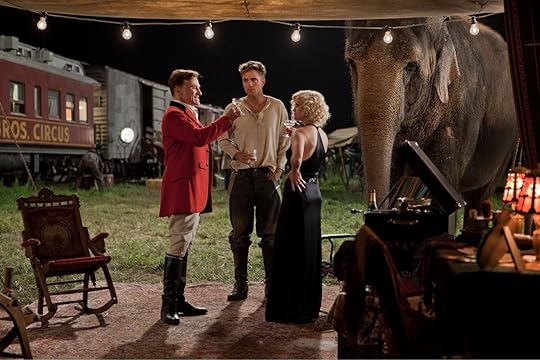
#7 – Create a Sense of Mystery.
Intrigue your audience by introducing elements of mystery and uncertainty that compel them to continue reading or watching in search of answers.
Consider “Shutter Island,” where the U.S. Marshal’s investigation into a patient’s disappearance immediately captivates viewers and sets the stage for a psychological thriller filled with twists and turns.
In literature, think of “Water for Elephants” by Sara Gruen, where the protagonist Jacob Jankowski’s reminiscence about his past life as a circus performer hints at hidden secrets and intrigues.
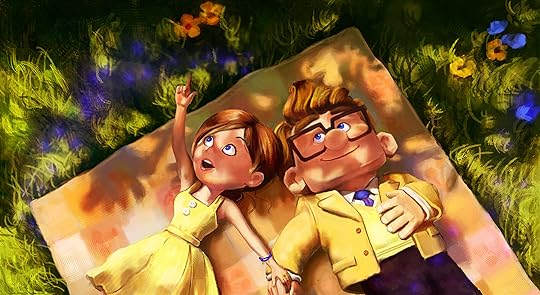 #8 – Evoke Strong Emotions.
#8 – Evoke Strong Emotions.
Forge a deep emotional connection with your audience by eliciting strong emotions from the start.
My favourite example is the opening of the animated movie “Up,” where a poignant montage chronicling the lifelong love story of Carl and Ellie immediately captures viewers’ hearts and sets the tone for the film’s emotional journey.
In literature, consider “The Kite Runner” by Khaled Hosseini, where the opening scene immediately evokes strong emotions through its vivid portrayal of a kite-flying competition in Kabul, Afghanistan.
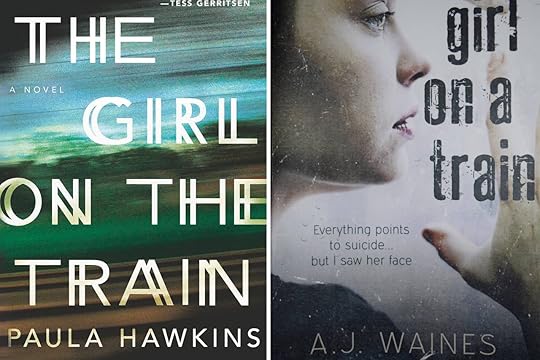 #9 – Set an Atmosphere of Suspense.
#9 – Set an Atmosphere of Suspense.
Keep your audience on the edge of their seats by setting an atmosphere of suspense that draws them into the narrative and keeps them invested in uncovering its secrets.
Think of “The Girl on the Train,” where the protagonist’s daily observations of her neighbours immediately establish an undercurrent of tension and unease that propels the story forward.
In cinema, consider “Twilight,” which opens with a mysterious and atmospheric scene of Bella Swan navigating her way through the foggy woods of Forks, Washington.
 #10 – Start with a Memorable Quote or Line.
#10 – Start with a Memorable Quote or Line.
Starting with a memorable quote or line is a powerful storytelling technique that instantly captivates readers or viewers and sets the tone for the narrative. Beginning with a memorable quote or line encapsulates the theme or essence of the story, leaving a lasting impression on the audience.
Think of “Star Wars: A New Hope,” which begins with the iconic line, “A long time ago in a galaxy far, far away…” immediately immersing viewers in the epic space opera adventure.
In literature, consider “Pride and Prejudice” by Jane Austen, where the memorable opening line, “It is a truth universally acknowledged, that a single man in possession of a good fortune, must be in want of a wife,” sets the stage for the novel’s exploration of love, social class, and gender roles in 19th-century England.
In Conclusion – mastering the art of the hook is essential for captivating your audience from the start and keeping them engaged throughout your story.
Whether you’re crafting a novel or a film, incorporating these 10 techniques with examples from both literature and cinema will help you grab your audience’s attention and leave a lasting impression that will keep them coming back for more.
Now it’s YOUR turn – I would love to hear what ways do YOU use to grab the attention of yoru readers or viewers?
Would love to get your input in the comment box below.
The post The Power of Hooks – Grabbing Attention from the Start appeared first on Vered Neta.
February 22, 2024
7 Lessons We Can Learn from the Rerun of “Suits”
Despite its last episode airing on USA Network in 2019, “Suits” has made a remarkable resurgence, captivating audiences across various streaming platforms like Netflix and Peacock.
According to Nielsen, it has now broken its record for most watched minutes on an “acquired” TV show (not one debuted by a streamer), with 3.1 billion minutes viewed in a single week in July 2023.
The show centred around a genius masquerading as a lawyer and the high-stakes world of a prestigious New York law firm, and it has garnered newfound attention, breaking numerous streaming records and sparking discussions among critics and viewers alike.
So, what exactly makes “Suits” such a hit even years after its initial run?
7 Key Lessons We Can Learn From its Unexpected Resurgence.

#1 – The Allure of Middlebrow TV.
In an era dominated by high-concept dramas and formulaic sitcoms, “Suits” stands out as a prime example of middlebrow television. It may not sweep award ceremonies or delve into profound philosophical themes, but it strikes a delicate balance between entertainment and substance, appealing to a wide audience seeking engaging yet accessible content.
For example, the show’s focus on legal intricacies and corporate power struggles offers enough depth to satisfy viewers looking for substance, while its witty dialogue and charismatic characters provide entertainment without overwhelming complexity.
 #2 – The Power of Predictability.
#2 – The Power of Predictability.
While viewers crave novelty, there’s a comforting appeal in predictability, especially in the realm of television. “Suits” masterfully navigates the fine line between familiarity and surprise, offering episodic plots peppered with occasional twists, keeping viewers hooked without overwhelming them with complexity.
For instance, the dynamic between Harvey and Mike follows a predictable pattern of mentorship and camaraderie, providing a sense of continuity amidst ever-changing case scenarios.
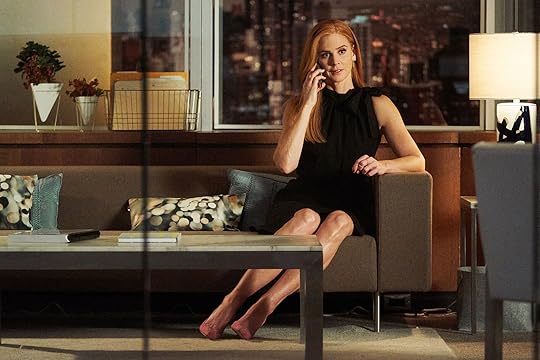
#3 – The Sweet Spot of Character Development.
Unlike sitcoms with static characters or intense dramas with exhaustive character arcs, “Suits” finds its sweet spot in character development. Each primary cast member is meticulously crafted, with compelling personal arcs that unfold alongside the main storyline, adding depth and relatability to the narrative.
For example, Donna’s evolution from a witty secretary to a strategic powerhouse showcases the show’s commitment to nuanced character growth.

#4 – Competency Porn and Workplace Dynamics.
With its sleek portrayal of competent professionals navigating high-stakes scenarios, “Suits” exemplifies the genre of competency porn. The show’s focus on workplace dynamics, from intricate office politics to interpersonal relationships, resonates with audiences seeking escapism within a familiar setting.
For instance, the firm’s strategic manoeuvres and legal acumen offer a glimpse into the exhilarating world of corporate law, while the interpersonal conflicts and power struggles add layers of intrigue and tension. marriage.

#5 – The Art of Banter and One-Liners.
A hallmark of “Suits” is its witty banter and memorable one-liners, which inject humour and levity into tense situations. From Harvey’s sharp retorts to Donna’s quick wit, the show leverages dialogue as a powerful tool to engage viewers and infuse the narrative with personality.
For example, Harvey’s iconic line “I don’t have dreams, I have goals” encapsulates his pragmatic and ambitious demeanour, while Donna’s quips add a touch of humour to even the most serious discussions.
Mike and Harvey have great banters, but their regular pop culture references add a layer of entertainment to their fun conversations. They usually quote movies to each other and even assign big screen characters roles depending on the case that they are dealing with. While the duo tends to do this the most, the rest of the firm actually also does it. Jessica quotes Top Gun, while Rachel recites Dirty Dancing. These function as some Easter eggs that make Suits so much more enjoyable to watch.
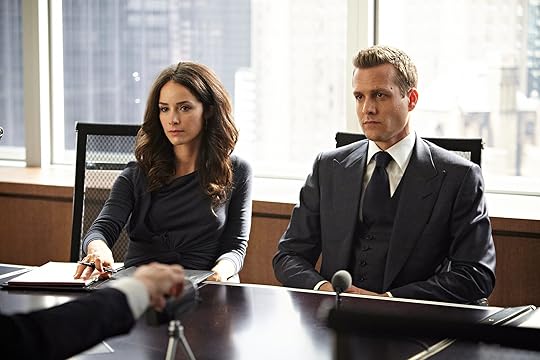 #6 – The Blend of Procedural and Serialized Elements.
#6 – The Blend of Procedural and Serialized Elements.
Balancing episodic procedural storytelling with overarching serialised arcs, “Suits” caters to viewers’ preferences for both standalone episodes and long-term narrative threads. This hybrid approach ensures that each episode offers resolution while contributing to the larger storyline, maintaining momentum throughout the series.
For instance, while the show features self-contained legal cases in each episode, it also weaves ongoing conflicts and character dynamics into the fabric of the narrative, creating a cohesive and engaging viewing experience.
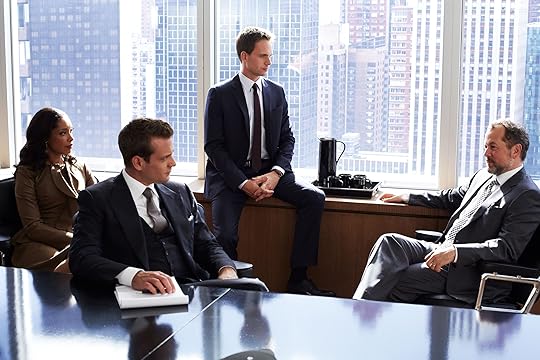
#7 – Nostalgia and Comfort Viewing.
In an ever-changing landscape of television, there’s a nostalgic appeal to revisiting familiar favourites like “Suits.” As streaming platforms compete for viewers’ attention with new releases, timeless shows like “Suits” provide a sense of comfort and familiarity, making them ideal choices for binge-watching and relaxation.
For example, the show’s return to streaming platforms allows both longtime fans and new audiences to indulge in the nostalgia of past seasons while discovering or rediscovering the charm of its characters and storylines.
Additionally, the disappearance of “Blue Sky” TV, characterized by light-hearted and easy-going programming like “Suits,” has inadvertently benefited streaming platforms like Netflix.
As traditional networks like USA Network shifted away from producing such content in favour of chasing the prestige television trend popularised by streaming giants, a gap emerged in the market for the kind of shows that offered viewers escapism and comfort.
Streaming platforms like Netflix capitalised on this void by acquiring and promoting shows like “Suits,” which perfectly catered to audiences seeking easy-to-watch, binge-worthy content. This shift in programming preferences underscores the evolving dynamics of the television industry and highlights the adaptability of streaming platforms in meeting viewer demands.
Now it’s YOUR turn – I would love to hear why YOU think “Suits” suddenly became so popular.
Would love to get your input in the comment box below.
The post 7 Lessons We Can Learn from the Rerun of “Suits” appeared first on Vered Neta.
February 15, 2024
Movie Night – Barbie – Redefining Fun and Femininity on the Silver Screen
Directed: Greta Gerwig
Writer: Greta Gerwig & Noah Baumbach
Starring: Margot Robbie, Ryan Gosling
Trivia: The swimsuit and overall look Barbie wears in the opening scene is a direct recreation of the original 1959 Barbie doll that first debuted in stores.
****************************************************
As we near the end of awards season, it’s disheartening to see the same old story play out once again. The Patriarchy seems to have struck once more, this time overlooking one of the boldest and most successful films of the year – Barbie.
Greta Gerwig, the mastermind behind this cinematic gem, and Margot Robbie, who brought the immortal doll to life with such brilliance, were inexplicably snubbed for nominations. Now, whenever we hear the name Barbie, it’s hard not to picture Margot Robbie’s unforgettable portrayal.
I must admit that when I first heard Greta Gerwig was directing a Barbie movie, I was like, “Wait, what?” I mean, after her stellar work on “Little Women,” I never imagined her diving into plastic doll territory. But boy, did she surprise us! And casting Margot Robbie as Barbie and Ryan Gosling as Ken? Genius move, if you ask me!
Fast forward to the trailers dropping and the summer showdown between Barbie, Oppenheimer and Mission Impossible #7. Barbie wasn’t just another blockbuster – it was THE movie everyone was talking about. And rightly so, because it smashed records left, right, and centre
Now, let’s tackle the big question: Can a movie that’s pure fun also be considered art? Absolutely! And Barbie is living proof.
5 Reasons Why Barbie is both Fun and Art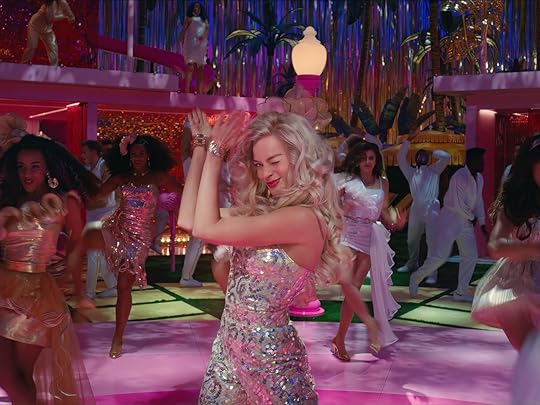 A Kaleidoscope of Joy.
A Kaleidoscope of Joy. From the opening scene’s electrifying neon credits to the final dance party explosion, “ Barbie ” was a visual feast.
Every frame pulsated with vibrant colours, whimsical costumes, and imaginative sets that transported us to a world where imagination reigned supreme. It was like stepping into a candy-coated dream, a welcome departure from the often-gritty realities of cinema.
Laughter is the Best Medicine: This movie was FUNNY. Like, laugh-out-loud, snort-milk-out-your-nose hilarious. Gerwig’s witty script, combined with the comedic genius of Margot Robbie and Ryan Gosling, delivered clever and relatable jokes.
From Ken’s existential crisis to Barbie’s hilariously literal interpretations, the humour never missed a beat, leaving audiences in stitches throughout.
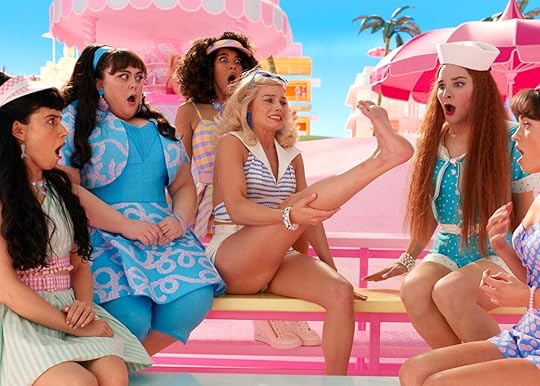
A Subversive Wink: Don’t let the pink fool you, “ Barbie ” wasn’t afraid to bite. Underneath the glitter and glamour, the film offered a playful yet insightful commentary on societal expectations, beauty standards, and the very nature of being a “ Barbie .”
It cleverly subverted the doll’s legacy while celebrating its inherent campiness, creating a nostalgic and refreshingly-mic film.
More Than Just Eye Candy: Sure, the costumes were outrageous, the sets extravagant, and the visuals stunning, but “ Barbie ” wasn’t just an empty spectacle.
It offered a surprisingly heartwarming message about self-acceptance, individuality, and the power of friendship. While wrapped in a layer of fun, the film’s core resonated, reminding us that true beauty lies within and that embracing our unique selves is the ultimate fashion statement.
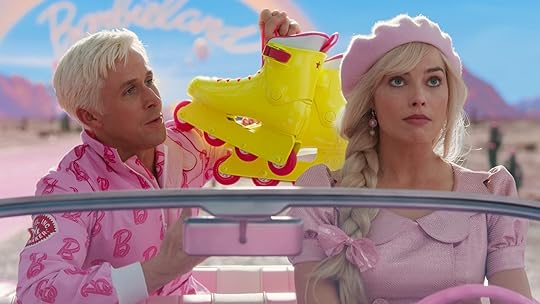
A Celebration of Play: In a world often bogged down by seriousness, “ Barbie ” reminded us of the simple joy of play. It encouraged us to tap into our imaginations, embrace silliness, and find humour in the everyday.
Awards recognition might have eluded “Barbie,” but its impact is undeniable.
It is a cinematic breath of fresh air, a joyous rebellion against the predictable, a reminder that sometimes, the most profound messages come wrapped in the brightest pink packaging.
So, if you crave pure, unadulterated fun for your Movie Night, remember, “Barbie” is waiting, ready to transport you to a world where laughter reigns supreme, and imagination knows no bounds. Just don’t forget your sense of humour and your dancing shoes!
Final Verdict – 5/5 Stars
In the comment box below, let me know which movie you chose for your “Movie Night” and why.
The post Movie Night – Barbie – Redefining Fun and Femininity on the Silver Screen appeared first on Vered Neta.
February 8, 2024
Movie Night – Movies Based on Video Games
In today’s fast-paced world of technological progress, the impact of video games, artificial intelligence (AI), and cutting-edge tech on filmmaking is more evident than ever before.
Taking cues from beloved classics like “The Matrix” and “Lara Croft: Tomb Raider,” modern-day movies such as “Uncharted,” “Free Guy,” and “Ready Player One” showcase a delightful blend of these influences.
Let’s take a closer look at how the evolution of technology, video games, and AI fuels innovation in cinema.
In today’s “Movie Night,” I’ll delve into these three captivating films, each offering a unique mix of adventure, humour, and virtual thrills.
So, grab your popcorn and join me as we dive into these movies, helping you pick the perfect cinematic treat for your next movie night!
 “Uncharted” – A Thrilling Expedition into the Unknown.
“Uncharted” – A Thrilling Expedition into the Unknown.Let’s kick things off with “Uncharted” (2022), a film directed by Ruben Fleischer and starring Tom Holland and Mark Wahlberg. Inspired by the acclaimed video game series developed by Naughty Dog, “Uncharted” follows the daring exploits of treasure hunter Nathan Drake as he embarks on a globe-trotting quest filled with perilous obstacles and ancient mysteries.
At its core, “Uncharted” is a high-octane adventure that captures the spirit of the video game franchise while offering a fresh perspective for both fans and newcomers alike. Critics praised the film’s charismatic performances, particularly Tom Holland’s portrayal of Nathan Drake, which injects youthful energy and charm into the character.
However, despite its thrilling action sequences and stunning visuals, “Uncharted” faced criticism for its predictable plot and lack of character development. Some reviewers noted that the film felt derivative, drawing too heavily from classic adventure films like “Indiana Jones” and “The Goonies.”
From a writer’s perspective, “Uncharted” is a testament to the importance of authenticity in adapting video games for the big screen. By staying true to the essence of the game while offering a cinematic narrative that stands on its own merits, the film successfully immerses audiences in the thrill of the adventure.
 “Free Guy” – A Hilarious Dive into Virtual Reality.
“Free Guy” – A Hilarious Dive into Virtual Reality.Next up, we have “Free Guy” (2021), directed by Shawn Levy and starring Ryan Reynolds. Set within the vibrant metaverse of “Free City,” the film follows an NPC named Guy, who becomes self-aware and embarks on a journey to break free from his scripted existence.
“Free Guy” offers a fresh take on the video game movie genre, blending action-packed hijinks with heartfelt humour and insightful commentary on gaming culture. Critics praised Ryan Reynolds’s charismatic performance and the film’s inventive premise, which explores themes of agency, identity, and the power of imagination within the context of a virtual world.
Despite its innovative approach, “Free Guy” faced criticism for its reliance on clichés and uneven tone. Some reviewers felt that the film’s humour relied too heavily on pop culture references, which may not resonate with all audiences.
Looking at it through the eyes of a writer, “Free Guy” stands out as a fascinating study of blending genres and subverting expectations. By combining action-comedy elements with introspective storytelling, the film offers a refreshing take on the video game movie formula, challenging creators to think outside the box when adapting interactive narratives.
 “Ready Player One” – A Dazzling Tribute to Pop Culture.
“Ready Player One” – A Dazzling Tribute to Pop Culture.Finally, we come to “Ready Player One” (2018), directed by Steven Spielberg and based on the novel by Ernest Cline. Set in a dystopian future where people escape their harsh reality by immersing themselves in a virtual reality world called the OASIS, the film follows a group of gamers on a quest for fame and fortune within the digital realm.
“Ready Player One” celebrates the power of nostalgia and the enduring appeal of pop culture references, weaving a tapestry of iconic characters and settings from various franchises. Critics praised the film’s visually stunning depiction of the OASIS and Steven Spielberg’s masterful direction, which captures the source material’s spirit while infusing the story with heart and excitement.
However, despite its visual splendour, “Ready Player One” faced criticism for its excessive length and reliance on nostalgia. Some reviewers felt the film’s pacing was uneven, with certain scenes dragging on while others felt rushed.
For the writers among us, “Ready Player One” presents a unique challenge in balancing homage with originality. By incorporating familiar elements of video games and pop culture history while crafting an engaging narrative, the film demonstrates the importance of striking a delicate balance between nostalgia-driven fan service and innovative storytelling.
IN CONCLUSION:“Uncharted,” “Free Guy,” and “Ready Player One” offer a diverse array of cinematic experiences that showcase the creative potential of video game-inspired movies. From thrilling treasure hunts to meta-commentary on gaming culture, each film brings something unique to the table, inviting audiences to embark on unforgettable journeys into the realms of adventure and virtual reality.
As Hollywood continues to explore the intersection of video games and cinema, these movies serve as valuable examples of the creative synergy between technology, storytelling, and audience engagement. Whether you’re a fan of action-packed adventures, heartfelt humour, or nostalgic nostalgia trips, there’s something for everyone in the exciting world of video game-inspired movies. So grab your popcorn, settle in, and get ready to embark on an epic cinematic adventure unlike any other!
In the comment box below, let me know which movie you chose for your “Movie Night” and why.
The post Movie Night – Movies Based on Video Games appeared first on Vered Neta.
February 1, 2024
Movie Night – Oppenheimer
Directed: Christopher Nolan
Writer: Christopher Nolan (adaptation), Kai Bird (book), Martin Sherwin
Starring: Cillian Murphy, Emily Blunt, Robert Downey Jr.
Trivia: When asked what he wants to name the bomb at Los Alamos, Oppenheimer mutters “Batter my heart, three-personed God” before saying “Trinity.” This is from the first line of John Donne’s Holy Sonnet 14, which refers to the holy trinity.
****************************************************
Are you ready for the exhilarating ride through the glitz and glamour of Awards Season?
When it’s time to pick the perfect movie for Movie Night, we can’t help but be intrigued by the stellar films competing for those coveted awards. Over the next few weeks, I’ll be your guide on this cinematic adventure. And, unless you lived under a rock over the past year, you’ve likely caught wind of the epic showdown between “Barbie” and “Oppenheimer.”
This week, let’s dive into the enthralling world of “Oppenheimer.
Christopher Nolan’s “Oppenheimer” takes us on a mesmerising journey into the brilliant mind of J. Robert Oppenheimer, the mastermind behind the Manhattan Project and the unleashing of the atomic bomb on the world stage. Prepare to be captivated as the film seamlessly weaves historical events with psychological introspection, painting a nuanced portrait of a man wrestling with the profound implications of his creation.
Cillian Murphy delivers a performance that will leave you spellbound, portraying Oppenheimer with intellectual brilliance, unwavering dedication, and the agonising moral conflict that defined him. For those who’ve been following Murphy’s career, this role showcases his brilliance as an actor. Trust me, it’s worth watching just for his outstanding performance.
Nolan’s visual storytelling prowess shines throughout the film, whisking viewers away with sweeping landscapes, meticulously crafted sets, and jaw-dropping slow-motion sequences that immerse us in the urgency and secrecy of the Manhattan Project. Distorted imagery and haunting soundscapes intensify the emotional impact, making it an experience you won’t forget.
But, like any ambitious project, “Oppenheimer” has its challenges. Clocking in at three hours and two minutes, it might test the patience of some viewers, especially those unfamiliar with the intricacies of the Manhattan Project. The complex plot and scientific jargon might require a bit more engagement from the audience, but trust me, it’s worth the investment.
While the film tackles weighty themes of war, destruction, and the responsibility of science, it occasionally struggles to find the right balance between intellectual depth and emotional resonance. Moments of humour, though serving to lighten the mood, can feel a tad jarring, hindering the film’s ability to capture the emotional impact of its subject matter fully.
Now, here’s the heart of the matter for me—movies are all about characters, relationships, and emotions. Nolan’s films excel in themes, cinematography, and action, but emotions and relationships are sometimes kept at arm’s length. In “Oppenheimer,” this is the “Achilles’ heel” of the movie. Despite Emily Blunt’s and Florence Pugh’s excellent performances, the emotional ties between Oppenheimer and the women in his life feel somewhat “flat.” We are left in the dark about what initially attracted him to them, the depth of his emotions towards them, and the significance they held in his life.
Yet, despite these minor quibbles, “Oppenheimer” stands tall as a cinematic triumph that demands your attention. Nolan’s masterful direction, Murphy’s captivating performance, and the film’s stunning visuals combine to create a powerful and thought-provoking experience. For those willing to dive into its complexities, “Oppenheimer” offers a profound exploration of human ambition, morality, and the profound consequences of scientific progress. It’s a journey you won’t want to miss!
Final Verdict – 5/5 Stars
Would love to get your impressions and thoughts about the movie in the comment box below.
Let’s start a conversation.
The post Movie Night – Oppenheimer appeared first on Vered Neta.
January 25, 2024
BOOK VS. TV SHOW: Lessons in Chemistry
Ever found yourself questioning the current state of feminism? As a long-time feminist, that was me, too. But then “Lessons in Chemistry” by Bonnie Garmus happened. It was everywhere – on “best” and “favourite” lists – and I needed to know why.
Let it be clear – chemistry isn’t my thing, and lessons in it? It’s even less exciting. Yet, here I am, thanking my lucky stars I didn’t let my indifference to chemistry rob me of an incredible read.
The book should have a warning sign on it in the direction of – “The author assumes no liability for readers who lost sleep, skipped work, forgot to eat, or neglected childcare duties because they felt compelled to continue reading nonstop”. All the above happened to me (except childcare). When I finished reading, I knew it was too good of a book not to be turned into a script. My only question was, will it be a TV show or a feature? I was happy it was turned into a TV miniseries because making it into a feature would have to cut too much of the good stuff that is in the book.
After watching the fantastic Apple TV show, I just had to dive into “Books vs TV Show” segment. So here it is for your verdict.
 The Book
The BookMeet Elizabeth Zott, the culinary powerhouse at the heart of “Lessons in Chemistry.” Before gracing television screens as a charismatic chef who transforms 1950s-era America’s cooking habits, she wore the lab coat of an underappreciated chemist. And why was she undervalued? Not for any lack of chemistry prowess but simply because she dared to be a woman in a less-than-empowering 1950s America.
The Hastings Research Institute, her workplace, isn’t exactly a feminist utopia. It thrusts Elizabeth into a world of minor lab projects, pitiful pay compared to her male counterparts, and the unsolicited expectation that she’d play secretary instead of a serious scientist. Miss Frask, the living embodiment of outdated stereotypes, scolds Elizabeth for being “unladylike,” oblivious to concepts like feminism and sisterhood.
Enter Calvin Evans, the institute’s golden boy. Initially, their relationship kicks off with a beaker-based misunderstanding, but Calvin swiftly recognises Elizabeth’s talent and ambition. Love blooms in an unexpected chemical reaction, literally, as Calvin crashes into her life,
spewing vomit on her shoes. What follows is a love story that transcends the lab, but tragedy strikes when Calvin dies, leaving Elizabeth with a broken heart and a burgeoning belly.
Against the backdrop of the 1960s, Elizabeth, refusing to tie her work to Calvin’s name, faces the complexities of single motherhood and societal judgment. A lunchbox-stealing incident catapults her into the world of television, where Walter Pine, captivated by her brilliance and culinary skills, pitches the idea of a cooking show. Reluctantly accepting due to financial pressures, Elizabeth unknowingly sets in motion a sizzling sensation, inspiring women to dream big in her show “Supper at Six”. However, at heart, she is still a chemist, and she continues with her efforts at home, where she has turned her kitchen into a lab. As the story continues and her daughter Mad insists on discovering more about her unknown father (Calvin), she leads the readers and Elizabeth to a “happy ending” where Elizabeth returns to her true role as a chemist.
 My Review
My ReviewExpressing love for a book can be a delightful challenge, and “Lessons in Chemistry” has me grappling with the sheer joy it brought me.
First, let’s dispel any misconceptions – “Lessons in Chemistry” isn’t your typical romance novel. If you’re seeking that, you might be tempted to walk away but trust me, you’d be missing out on a phenomenal story.
Here’s why “Lessons in Chemistry” is an absolute gem:
The Plot: As I mentioned above there should be a warning sign on the book on how gripping the story is. I was swept away by the unexpected twists and turns and couldn’t put down the book. Some moments were horrifying, others delightful, and I found myself utterly unprepared for the rollercoaster ride the plot took me on. You know those books that you keep telling yourself “One more chapter and then I’ll go to sleep” only to find that it’s already 6:00 am and you need to start your day?… That kind of story!
The Writing: This is the kind of book that makes me “hate” the author, or tell myself “When I grow up I want to write like that”. The writing is sharp, clever, layered, and absolutely riveting. It weaves a narrative filled with unexpected perspectives, offering insight into characters’ lives, thoughts, and emotions.
The Characters: Elizabeth is a force to be reckoned with – fiercely intelligent, determined, pragmatic, and unflappable. Her refusal to conform to societal expectations regarding her gender is not only empowering but deeply inspiring. The other characters are equally compelling, ranging from quirky and lovable to surprisingly endearing, and yes, a few consistently evil ones that fuel the reader’s righteous rage.
The Message: This book feels like a heartfelt thank-you to the trailblazing women of the ’50s and ’60s, a rallying cry for anyone who’s felt undervalued and confined to roles they never wanted. Themes of love, resilience, loss, family, and friendship make it a perfect candidate for a book club discussion. It’s a story that evokes both frustration and upliftment, resonating deeply with women who’ve felt unseen and unheard.
“Lessons in Chemistry” is more than a story; it’s a personal journey. It reminded me of the core reasons I embraced feminism. Elizabeth’s strength, the quirks of those around her, and the triumphs of chemistry beyond the lab make this book a fantastic celebration of feminist strides.
 TV Show
TV ShowBook lovers often squabble over adaptations, but Apple TV+’s take on “Lessons in Chemistry” is like a glamorous makeover for your beloved story! Showrunner Lee Eisenberg steps in to fix plot holes and sprinkles in some extra flavour to demystify those head-scratching twists and delve deeper into the era’s politics.
The show stays true to the book’s journey, whisking us back to the 1950s and 1960s alongside the fabulous Brie Larson as Elizabeth Zott. She’s on a mission to conquer the scientific realm, battling systemic sexism and giving a piece of her mind to some seriously misogynistic bosses. And did I mention the delightful rom-com vibe, heartstring-tugging moments, and a dash of historical fiction? Oh, and there’s a talking dog—or a dog with a chatty inner monologue.
The cast gets a diversity boost to keep up with the times, and secondary characters get their chance in the limelight. Harriet, Elizabeth’s neighbour (played by the amazing Aja Naomi King), isn’t just a nosy neighbour anymore; she’s a true friend, an attorney, and a Civil Rights advocate. Minister Wakely (portrayed by Patrick Walker), Calvin’s pen pal, takes centre stage, injecting depth into discussions on faith and science.
As for the romance! The small-screen adaptation spices up the central love story with subtle changes. While the book’s feminist lessons sometimes felt like a refresher course, Brie Larson brings the no-nonsense scientist Elizabeth Zott to life with impeccable precision. Lewis Pullman, as Calvin, adds an extra layer of charm to the romance. These tweaks make the romantic duo even more captivating on screen.
So, it’s time to take a peek at the changes and decide whether the book or the TV show takes the crown.
 Changes
ChangesThe Love Story – Elizabeth and Calvin’s courtship starts on a fiery note.
Do you know that classic “enemies-to-lovers” trope we all secretly adore? Well, both Bonnie Garmus and Lee Eisenberg nailed it in their own unique ways.
In the novel, Elizabeth kicks off their dynamic by snagging beakers from Calvin’s lab, leading to an intense war of words. But the TV show takes it up a notch with Elizabeth’s sneaky move involving ribose for her late-night experiments. However, Elizabeth, with her determined spirit, is unknowingly caught in the crosshairs of the ultimate busybody, Fran Frask ( Stephanie Koenig).
That leads Elizabeth to be forced to participate in the cringe-worthy “Little Miss Hastings” pageant, all in the name of team spirit. It’s another great example of the life women in the workforce in the 50s had to suffer. The pageant is the scene for the great vomit incident. It’s a hilarious twist that replaces the book’s Mikado performance, shedding light on their isolation within the Hastings community. Let’s say it’s a moment that had me cringing and laughing all at once
 Harriet’s character undergoes one of the biggest changes.
Harriet’s character undergoes one of the biggest changes.
Let’s talk about Harriet from “Lessons in Chemistry”! In the book, Harriet is portrayed as a middle-aged Catholic white woman with a tough situation – an abusive husband and kids who’ve flown the coop, leaving her feeling lonely and stuck in a marriage she doesn’t cherish.
Fast forward to the TV adaptation, and we meet a whole new Harriet, played brilliantly by Aja Naomi King. Here’s the twist: Harriet is now portrayed as a Black woman, but the changes don’t stop there. The show takes Harriet’s character to a whole new level, giving her a fresh backstory and personality that goes beyond her name and role as Elizabeth’s neighbour.
In the show, Harriet is a dynamic character with two young children closer in age to Elizabeth. Her husband is away serving as a military surgeon in the Korean War, which adds a unique dynamic to her story. And guess who steps in to help when Harriet needs a hand? None other than Calvin himself offers to babysit and solidify their bond even before Elizabeth enters the picture.
But that’s not all. Harriet isn’t just a supportive neighbour in the show; she’s an ambitious woman using her legal aid expertise to fight for her community. The storyline involving plans to expand the freeway adds depth and relevance, drawing from real-life historical injustices faced by communities like hers in states like California.
This transformation of Harriet from page to screen is significant because it shows that she’s not just a side character there to support Elizabeth. Her story is rich and impactful in its own right, highlighting themes of community, resilience, and the power of friendship that are central to the series.
 Calvin Proposes To Elizabeth & She Says No – Calvin is less traditionally minded in the miniseries.
Calvin Proposes To Elizabeth & She Says No – Calvin is less traditionally minded in the miniseries.
In the book, Calvin’s proposal is a big public affair. Picture this: he gets down on one knee in the middle of the cafeteria, ring box in hand, pouring his heart out for all to see. It’s quite the spectacle, but Calvin doesn’t take it well when Elizabeth turns him down because she wants her work to speak for itself. He throws a bit of a tantrum, and I must admit, it felt a bit out of character for him. Calvin, being mostly an introvert, displaying such emotions in a public place seemed a bit far-fetched to me. However, it also shows how much Elizabeth has changed him and his willingness to express his feelings boldly.
Now, in the miniseries, things take a different turn. Calvin and Elizabeth have a calm conversation about marriage and children in the comfort of their own bed. Elizabeth makes it clear that she never wants to get married or have kids, and surprisingly, Calvin accepts her decision without any drama. It’s a quieter, more intimate moment that showcases mutual respect for each other’s wishes. However, I couldn’t help but feel like it was a bit too modern for the 50s as if Calvin was conforming to the standards of “well-behaved men” of the 21st century rather than the societal norms of the time.
While Calvin’s reaction in the book may seem more dramatic, it adds a layer of realism to his character. He’s grappling with his own beliefs about relationships and gender roles, but ultimately, his love and respect for Elizabeth drive him to grow and learn, regardless of the era’s expectations.
 Calvin’s Accident
Calvin’s Accident
Calvin had this peculiar habit of jogging, which was quite unusual back in the 1950s and 1960s. It was like he was ahead of his time, considering the jogging craze didn’t kick off until the 1970s. Elizabeth wasn’t exactly thrilled about it, especially when it rained. But when the city passed its first leash law, Elizabeth suddenly became concerned about Six-Thirty’s safety and wanted him tethered to her during their runs. Despite his initial reluctance, Calvin saw Elizabeth’s nurturing side and agreed to use the leash.
Now, in the TV series, things take a slightly different turn. Elizabeth surprises Calvin with a leash for Christmas so that he can have Six-Thirty as a running buddy. It’s a sweet gesture but removes the context of the time period and Calvin’s reservations about being tethered. Instead, it’s Six-Thirty who doesn’t take well to the leash, and his stubborn behaviour is showcased in a dramatic scene in episode 2, where Calvin is almost hit by a bus.
While it may seem like a small detail, these little quirks are what make “Lessons in Chemistry” so captivating. Garmus cleverly weaves in these details to foreshadow events and add depth to the story. In the book, Elizabeth feels a profound sense of guilt over Calvin’s death, partly because of the leash, which adds emotional weight to the narrative. However, in the TV series, some of these nuances are inevitably lost in translation, resulting in a slightly different emotional and logical depth.
 When Hastings Fired Zott – The book made this scene even crueller.
When Hastings Fired Zott – The book made this scene even crueller.
In both versions, Elizabeth faces the devastating blow of being fired for being unwed and pregnant. However, the timing differs slightly between the two. In the book, this unjust termination happens almost immediately after Calvin’s funeral, thanks to Frask’s discovery. This meant Elizabeth didn’t have to deal with Mr. Astor’s correspondence in the months following Calvin’s passing, unlike in the miniseries.
Just like in the miniseries, Elizabeth fiercely protests against this unfair treatment, but Donatti, the antagonist in this scenario, refuses to let her walk away easily. In the book, Donatti drops a bombshell revelation that Evans had threatened to leave Hastings if he didn’t fund Elizabeth’s research independently of Calvin’s. This revelation shocks Elizabeth, who had believed she had succeeded on her own merit despite facing sexism in her field.
Donatti then cruelly forces Elizabeth to sign a termination form that prohibits her from discussing the reasons for her departure with anyone and strips her of her salary and healthcare. The scene in the miniseries is undoubtedly harsh. Still, the book truly emphasises the extent of Donatti and Frask’s cruelty towards Elizabeth, highlighting the stark realities of sexism and discrimination she faces.
 Elizabeth Is A Lab Tech, Not A Chemist
Elizabeth Is A Lab Tech, Not A Chemist
In the book, Elizabeth is depicted as a chemist with her own team and lab techs, each with their own levels of respect towards her. However, the TV show takes a different route by portraying Elizabeth as a lab tech rather than a chemist. This change limits her professional capacity and adds an interesting layer to her character dynamics.
Despite having a master’s degree in chemistry (no PhD), Elizabeth faces dismissive attitudes from some of her male colleagues and superiors. This underemployment in the 1950s reflects her challenges in being perceived as just another pretty face and a glorified secretary. The addition of the “Little Miss Hastings Pageant” in the TV show further highlights these dynamics, showcasing how Elizabeth’s position as a lab tech complicates her relationships in the workplace, especially with Calvin.
This change also impacts the ending of the story. While the book concludes with Elizabeth being offered a prestigious position at Hastings Research Institute after Donatti’s dismissal, the TV show takes a different route. The miniseries’ final episode sees Elizabeth teaching Introduction to Chemistry, a subtle nod to the show’s title. This alteration likely stems from the decision to portray Elizabeth as a lab tech rather than a chemist, shaping the trajectory of her professional journey.
These changes add depth and complexity to Elizabeth’s character arc, offering viewers a fresh perspective on her struggles and triumphs in a male-dominated field.
 Additions
AdditionsTurning Harriet into a black activist brings a whole new layer of depth to the story that wasn’t present in the book. The fight against the highway construction in their neighbourhood, culminating in the freeway protest, is a significant addition that amplifies the civil rights storyline and adds a powerful dimension to Harriet’s character.
In the book, Harriet’s character remains relatively unchanged. The changes she finally makes directly result from Elizabeth’s empowerment lessons through her TV show. But the miniseries takes the opportunity to delve into her activism and her challenges as a black woman in the 1950s/60s. The freeway protest, a pivotal moment in the series, highlights Harriet’s resilience and determination to fight for her community’s rights.
Moreover, the inclusion of diverse characters like Harriet, her husband, children, and Reverend Wakely enriches the miniseries and addresses a notable critique of the book’s lack of racial diversity. These characters aren’t just added for the sake of diversity; they are integral to portraying the realities of life for black individuals during that era.
By exploring the lived experiences of these characters, the “Lessons in Chemistry” miniseries goes above and beyond the source material, offering viewers a more nuanced and inclusive portrayal of the 1950s/60s society. It prompts us to reflect on our own views on progressiveness and the importance of standing up for what’s right, even in the face of adversity.
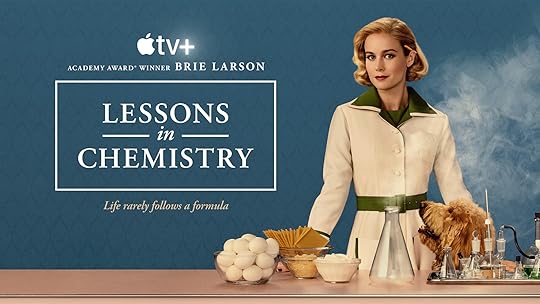 Verdict
VerdictMaking a choice between the book and the TV show of “Lessons in Chemistry” was tough. Both had me rooting for the characters, but ultimately, the book left a more powerful impact on me.
For me, the heart of this story is all about feminism and empowerment. The book captured this theme so beautifully, focusing on Elizabeth Zott’s journey in a way that felt authentic and impactful. However, I felt that the TV show tried to tackle too many additional topics, which diluted the core message.
While I appreciate the effort to introduce more diversity, especially with the addition of a POC storyline, it sometimes felt like it took away from Elizabeth’s unique and captivating narrative. The quirky charm of Elizabeth’s story seemed to get lost amidst the various subplots introduced in the show.
In the book, we hear the story primarily through Elizabeth’s perspective, with the hilarious addition of Six-Thirty’s inner thoughts. This dynamic kept the narrative focused and engaging. However, in the TV show, they dedicated entire episodes to side characters like Six-Thirty, which, while enjoyable, didn’t necessarily add much to the main storyline.
Ultimately, while I appreciated certain aspects of the TV show, including the exploration of additional voices, I found that the book stayed true to the essence of Elizabeth’s journey, making it a more impactful and memorable experience for me.
Now it’s YOUR turn – Tell us what you think about the adaptation of the book to the TV Show in the comment box below.
The post BOOK VS. TV SHOW: Lessons in Chemistry appeared first on Vered Neta.
January 18, 2024
Movie Night – Golda
Directed: Guy Nattiv
Writer: Nicholas Martin
Starring: Helen Mirren, Liev Schreiber
Trivia: The song at the end of the movie is “Who by Fire” by Leonard Cohen. It is based on a prayer said by Jews during Yom Kippur. Cohen travelled to Israel in October 1973 to perform a series of concerts, which inspired him to write this song, which appeared on his 1974 album, “New Skin for the Old Ceremony.”
****************************************************
You know how some movies get hyped as “THE BEST,” but when you revisit them, the excitement doesn’t hold up? Conversely, certain films gain significance and meaning as the years roll by.
“Golda,” released this summer, initially didn’t pique my interest, despite being a Helen Mirren fan. Golda Meir, as the only female prime minister in Israel, didn’t strike me as a feminist icon. She seemed more like a “male” figure, a sentiment echoed by Ben Gurion’s infamous comment about her having the “balls” to tell him the truth.
This scepticism intensified with the film’s release and reviews.
Enter… October 07.
That day felt like history repeating itself, stronger and scarier. Suddenly, the movie became relevant, forcing a reconsideration of Golda’s leadership during the Yom Kippur War. Perhaps the woman blamed for the war’s failure was more adept at crisis management than the men around her, certainly more than the current so-called “leadership”.
This year was filled with many biopics. The most famous is, of course, “Oppenheimer” by Christopher Nolen, but we also saw “Napoleon” by Ridley Scott and “Maestro” by Bradley Cooper. Like any other biopic, the major question for any screenwriter and director is whether to focus on one singular event in that person’s life or to give a whole “from cradle to death” story.
“Golda“, featuring Helen Mirren, focuses on the intense 19 days of the Yom Kippur War. Despite some flaws, the film weaves a compelling narrative that keeps you engaged. Mirren’s sensational performance elevates the movie, even in moments that edge towards repetition.
The film creates tension and captures war’s horrors without relying on flashy battle sequences. Scenes from a helicopter overlooking the battlefield or the chilling radio chatter provide subtle yet powerful moments. The action unfolds in war rooms, reminiscent of Princess Leia’s strategic planning, where characters react to unsettling radio chatter, delivering a poignant and emotional experience.
Golda’s personal touch, particularly her concern for casualties, stands out. The film wisely avoids drowning in military details, focusing on the emotional toll of war. Mirren’s portrayal of Golda, with impeccable makeup and a captivating accent, captures the duality of a woman grappling with anxiety yet projecting confidence and humour.
Her leadership style, although controversial, makes you yearn for such strength and trustworthiness in today’s political arena where there are no “Leaders” only politicians.
While the film could have explored more facets of Golda’s life, it sparked curiosity about its subject. Mirren’s charismatic portrayal makes you want to delve deeper into this controversial figure. A historical movie encouraging the audience to learn more is undoubtedly a success.
For those expecting grand battle sequences, “Golda” may not fit the bill. It’s more of a dialogue-heavy drama, focusing on behind-the-scenes political manoeuvres. However, this decision adds a unique dimension to the storytelling, enhancing the overall viewing experience.
Beyond Mirren’s outstanding performance, the cinematography surprises with excellence despite budget constraints. The following shots and handheld camerawork contribute to the film’s visual appeal.
In summary, if you’re interested in historical biopics and like dialogue-heavy dramas, this is definitely the movie for you to watch on Movie Night.
Verdict – 3.5/5 Stars
Would love to get your impressions and thoughts about the movie in the comment box below.
Let’s start a conversation.
The post Movie Night – Golda appeared first on Vered Neta.
January 4, 2024
Movie Night – Maestro
Directed: Bradley Cooper
Writer: Bradley Cooper and Josh Singer
Starring: Bradley Cooper, Carey Mulligan
Trivia: The first 47 minutes of the movie are in black and white, symbolising old Hollywood glamour.
I’m a huge fan of historical bios, and when you throw music into the mix, it automatically lands on my TBW (To Be Watched) movie list.
So, for my inaugural Movie Night segment, I eagerly dove into the captivating world of “Maestro,” brought to life by the brilliant Bradley Cooper, who directs and stars as the iconic Leonard Bernstein.
“Maestro” takes us on a thrilling ride through the pages of a traditional biopic, with Bradley Cooper skillfully steering the ship. Yes, it treads familiar waters with episodic storytelling, but don’t let that dampen your excitement. The film’s technical brilliance is like a dazzling symphony for your senses, leaving you in awe of Cooper’s meticulous attention to detail. Picture this: six years of preparation to conduct a pivotal scene that recreates Bernstein leading the London Symphony Orchestra. It’s not just a scene; it’s a breathtaking showcase of dedication, capturing the very essence of the legendary composer.
Now, imagine the movie unfolding like a lively scrapbook, filled with energy and kinetic pacing, highlighting Bernstein’s defining moments. Cooper plays with visual contrasts, seamlessly switching between black-and-white segments, aspect ratio shifts, and framing choices that mirror the conflicting dualities within Bernstein’s complex persona.
But “Maestro” isn’t just about the music; it’s a deep dive into Bernstein’s personal life, his relationships, and the struggle with his sexual identity. The film courageously explores the tension between Bernstein’s public image and his private battles, skillfully portraying his marriage to the captivating Felicia Montalegre, played with depth by Carey Mulligan. In fact, the film might as well have been titled “Leonard and Felicia” for the central role she plays in the narrative.
Sure, “The Maestro” might sidestep a few elements – at times, it feels as if it is an avoidance movie, shying away from sex, Judaism, and daring cinematic creativity. Cooper’s approach leans towards populism, aiming for broad appeal rather than diving into the controversial or challenging aspects of Bernstein’s life.
Yet, here’s where Cooper’s genius shines. His calculated approach crafts a film perfectly tailored for Netflix, the Oscar season, and a vast audience. Despite its critiques for being calculated and kitschy, “The Maestro” triumphs in delivering a romantic portrayal of Bernstein and Montalegre’s larger-than-life love story. Cooper’s skill as both a virtuoso and a populist is undeniable, making it a compelling and accessible cinematic experience.
So, If you’re a fan of non-linear storytelling, biopics, and music, then “Maestro” is tailor-made for you. My final rating after the cinematic experience?
A solid 3.5/5 stars.
Would love to get your impressions and thoughts about the movie in the comment box below.
Let’s start a conversation.
The post Movie Night – Maestro appeared first on Vered Neta.



